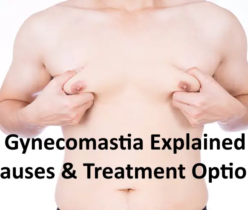Different Types of Gynecomastia Explained
When it comes to male breast enlargement, it’s important to understand that there are various causes and types of gynecomastia, each requiring specific treatment approaches to achieve a more masculine chest appearance.
If you’re considering gynecomastia treatment because your symptoms persist, it’s crucial to have a clear understanding of the type you might be dealing with before consulting a gynecomastia surgeon.
Let’s delve into the main types of gynecomastia:
Teenage Gynecomastia
Gynecomastia symptoms in teenagers and boys are commonly known as adolescent gynecomastia. This type is typically caused by natural hormone imbalances that occur during puberty. The key symptoms include:
- Chest tenderness or pain
- Increased sensitivity or soreness in the nipples
- Development of a small lump beneath the nipple
- Nipples appearing puffy or shiny
Gynecomastia symptoms may manifest on one or both sides of the chest, and the increase in breast size can be asymmetrical. While symptoms can start as early as age 10, they typically arise around the ages of 13 and 14. If the symptoms persist beyond two to three years, it’s unlikely for them to resolve on their own, making gynecomastia surgery a viable option.
Adult Gynecomastia
Commonly referred to as “man boobs,” adult gynecomastia is characterized by an excess of glandular breast tissue and fatty tissue. This combination contributes to a more feminized appearance of the male chest.
Adult gynecomastia can stem from persistent adolescent symptoms or develop later in life. Around the age of 50, there can be a decline in testosterone production, often referred to as male menopause. This hormonal change can cause gynecomastia symptoms in one out of four men between the ages of 50 and 80.
Steroid-Induced Gynecomastia
Men using anabolic steroids may experience gynecomastia symptoms as a side effect. Bodybuilders and athletes often use these steroids without a prescription to enhance performance, muscle growth, and muscle definition. However, an unwanted consequence called aromatization can lead to the formation of excess breast tissue instead.
Medication-Induced Gynecomastia
Gynecomastia can also be induced by certain prescription medications in both adolescents and adults. Some common medications associated with gynecomastia symptoms include those used for:
- High blood pressure
- Ulcers
- Prostate cancer
- HIV
- Depression (antidepressants)
Additionally, substances like marijuana (cannabis) and heroin have been known to cause gynecomastia symptoms.
Pseudogynecomastia
Pseudogynecomastia is a type of gynecomastia that doesn’t result from the growth of glandular tissue but rather from an accumulation of excess adipose (fat) tissue in the chest area. This can lead to similar symptoms as true gynecomastia, resulting in the appearance of male breasts or “man boobs.”

Both adults and adolescents can experience pseudo-gynecomastia, which often resolves with weight loss. However, individuals who are significantly overweight or obese may develop excess skin after losing weight throughout the body. In such cases, male breast reduction surgery and/or plastic surgery for body contouring can be considered to remove the excess tissue and achieve the desired results.
Understanding the different types of gynecomastia is crucial in developing an appropriate treatment plan tailored to your specific needs. Consulting with a qualified gynecomastia surgeon will provide you with the necessary guidance to address your concerns and restore a more masculine chest appearance





